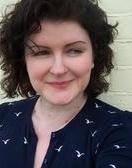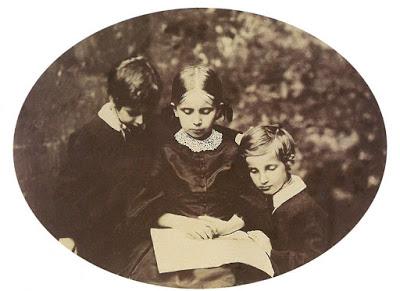 ,
,
Theodore, Sarah and Harry Acland (1856) Charles Dodgson
When Sarah Angelina Acland (Or 'Angie' as she preferred) was 7 years old, she and her brothers sat for an Oxford photographer named Charles Lutwidge Dodgson. They missed out on being his first group of children photographed, that honor going to their friends the Liddell girls. They were the children of Henry Wentworth Acland, Regius Professor of Medicine, and lived among the artistic and famous in Oxford. Miss Acland remembered Rossetti and gang painting the murals in the Union and occasionally giving her his palette. Ruskin stayed with them in their home and it was when Julia Margaret Cameron was paying visit to him that Miss Acland met the woman who would influence her later career. Ruskin did not admire Mrs Cameron's work and Miss Acland remembered Julia exclaiming 'John Ruskin, you are not worthy of photographs!' When Sarah Acland took up photography she at least managed something that Julia did not, photographing Ruskin.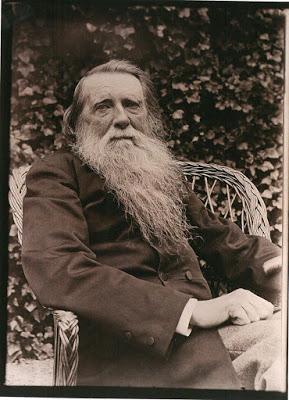
John Ruskin (1893)
Miss Acland's interest in art resulted in her parents encouraging her to take lessons from Ruskin to whom she grew very close. In 1870, their relationship became such a concern to her parents that he was moved out by her father, but she continued to see him and became for all intents and purpose his secretary.Photography in Oxford was a growing occupation with its implication in science, art appreciation, and travel. Angie's father assembled an album of photographs at home and offered encouragement to the upcoming photographers in their circle, including Charles Dodgson.
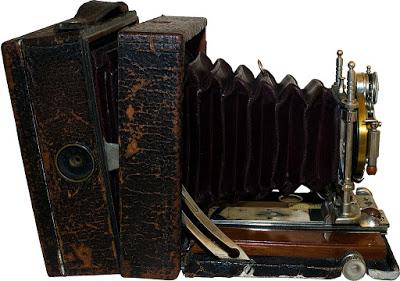
Kodak No. 3 (c.1890)
For her 42nd birthday, Miss Acland was given a Kodak No.3 camera by her father which must have been the ubiquitous present to give to the bored middle-aged woman in your life (really, I'm 42, I'd love one). She began her career, specialising in portraits of the ready-made assembly of the great and the good of Oxford. In 1899 she was described in Amateur Photographer as 'a lady amateur photographer who has applied herself chiefly to portraiture with quite extraordinary success.'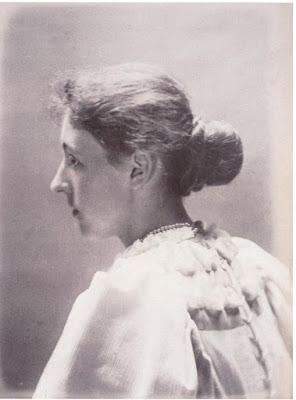
Miss M A Hope (1894)
Mary Agnes Hope was Miss Acland's god-daughter and one of her most frequent sitters. In a photograph that reminds me very much of George Charles Beresford's image of Virginia Woolf from almost a decade later, it is obvious that taking a 'likeness' of Miss Hope is not the primary reason for the photograph. The elegance of her profile, the interesting detail on the back of her blouse have more attention than what she looks like.
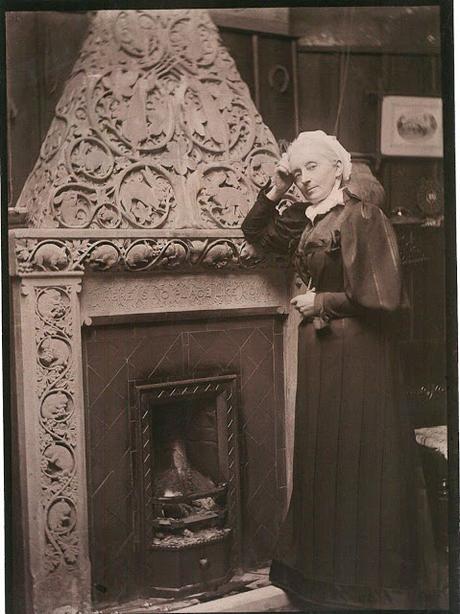
Miss Denniston (1895)
Gertrude Denniston was the Lady Superintendent of the Acland Nursing Home (named after Miss Acland's mother) and her closest friend outside her family. She is posed next to the incredible zoomorphic chimney piece in the Nursing Home, which has the Acland motto carved into it - 'There is no place like home'. The animals are utterly astonishing and make quite an impact in the picture. I'd like to think that a couple of them are wombats...
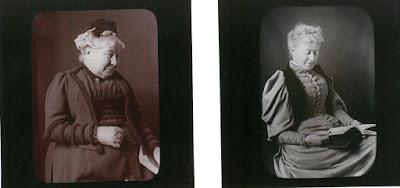
Mrs Peard (left) and Miss F. M. Peard (right) (1893)
Mrs Peard, a naval widow and her daughter were photographed while Miss Acland was overwintering in Devon. Frances Mary Peard was a novelist, author of 15 books and is presumably posed reading one, but I love the vaguely cheeky expression on her mother's face that shows marvelous spirit in the 88 year old's face.The reason that Sarah Angelina Acland is so important in the history of photography is not just for her skill but also for her pioneering work with color. In 1899 she began experiments in color by photographing a scene through 3 different filters (red, green and blue) then combining the images. This moved onto to a slightly more refined method of a screen of parallel red, green and blue lines providing composite images such as this beautiful image of poppies...
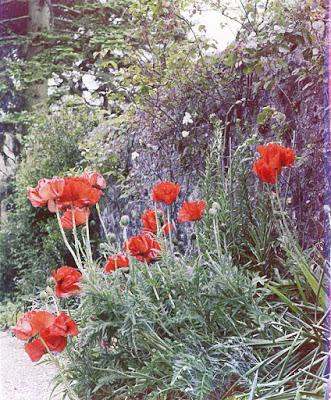
Oxford Garden (1905)
The invention of the Autochrome process in 1907 that sealed Sarah Angelina Acland's reputation as a pioneer. By this point, she had already given four lectures on color photography but with the advent of Autochrome things became a lot simpler. If I understand it, instead of having three separate plates to combine and make the colour, you stain potato starch the three colours and spread them over the glass plate in turn, then add your emulsion (which in this case is panchromatic). When you put your glass plate in the camera, instead of facing the emulsion to the lens (like I did with wet collodion), you turn the glass plate so that the image will pass through your coloured potato starch layers before getting 'stuck' on the sensitive emulsion. Ta da!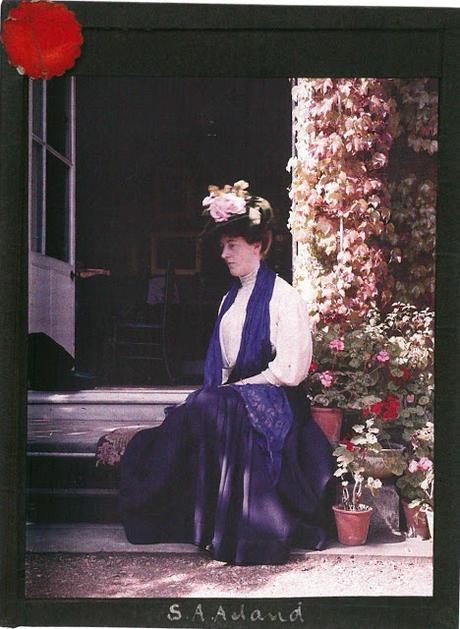
A Portrait Outdoors (1907)
I think that the marvelous thing about Autochrome is that the image is made out of tiny points of intense colour, so things like the red of the geraniums really hit you. A Portrait Outdoors shows Miss Acland's goddaughter Mary Agnes Brinton (nee Hope) on the steps of Clevedon House, Oxford. The image was awarded the red rosette (on the top left hand corner) in the 1908 Oxford Camera Club exhibition.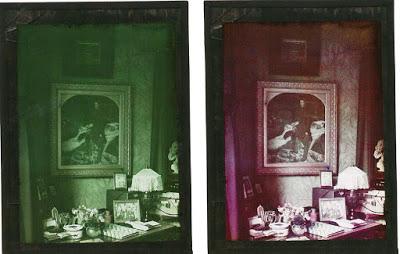
Spoiled Autochrome Plate (left) and digitally restored (right)
These two plates are the earliest color pictures of John Everett Millais' infamous portrait of Ruskin, hanging in Miss Acland's house in Oxford c.1913-17. The left is the spoiled plate where the green dye had spread and affected the finished color balance. On the right is a digital restoration to show how it should look. The picture above the Ruskin portrait, by the way, is We Are Seven by Elizabeth Siddal.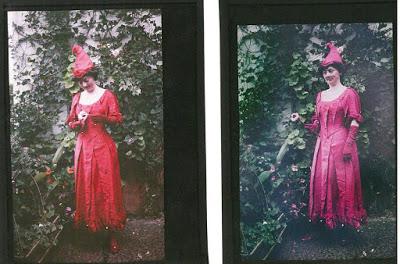
The Poor Thing (1911)
The above pictures were taken in Gibraltar where Miss Acland stayed with her brother, William, who was Admiral Superintendent of the Gibraltar dockyard. The picture on the left is an Autochrome whilst the right is a Dufay Dioptichrome plate, an attempt to make colours more 'true' and less extreme, by passing the light through a geometric filter screen which was finer and sometimes separate from the plate. The difference is marked as the color in the Autochrome plate is more vibrant, especially the red/green contrast.
Companions (1910)
This is a self portrait of Sarah Angelina Acland and the blur at her feet is her dog, Chum, taken in the garden of her home in Oxford. The Autochrome process required a long exposure time which means Chum becomes a fluffy blur.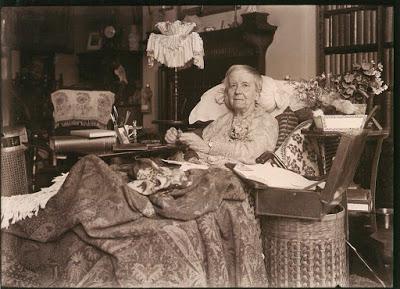
Self Portrait (1928)
This is the last known self portrait of Miss Acland, taken two years before her death, in her Oxford home. At her death, notices appeared in the British Journal of Photography and The Times praising her use of color and her excellent skills in portraiture. Her collection of negatives, prints and transparencies were eventually bequeathed to the Bodleian Library and her equipment to the Museum of the History of Science, where in the 1980s the collection was reconciled. The most beautiful catalog of her work, written by Giles Hudson is where I got the above pictures and information from. I cannot recommend it enough and it can be purchased from here (UK) and here (USA) and at a second hand bookshop of your choice, no doubt. I thoroughly recommend it. It would be lovely if, on this 200th Anniversary of Julia Margaret Cameron's birth we can also raise the profile of another pioneer of the photographic arts who derived so much inspiration from her.
Flora (1910)
